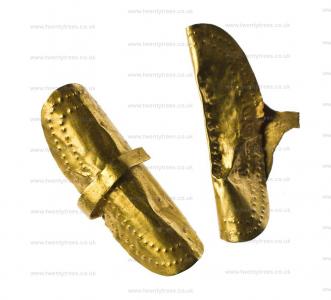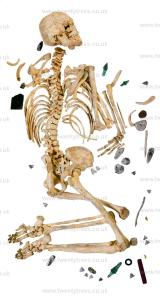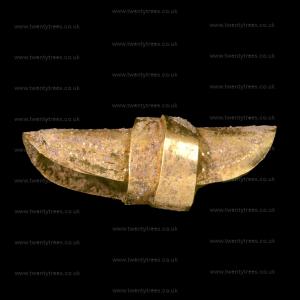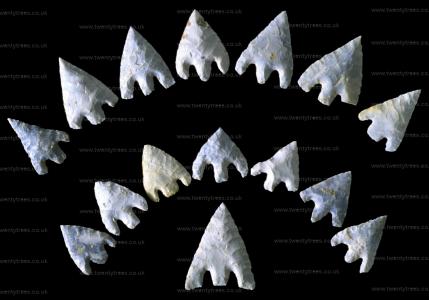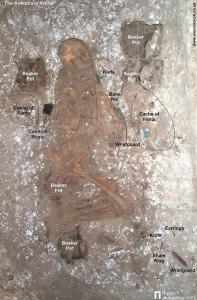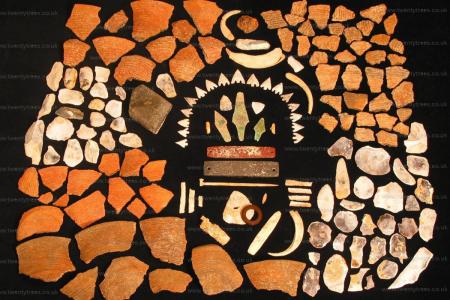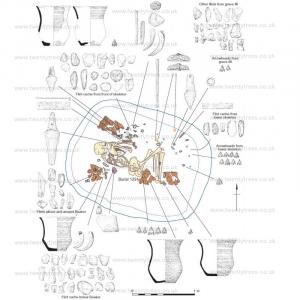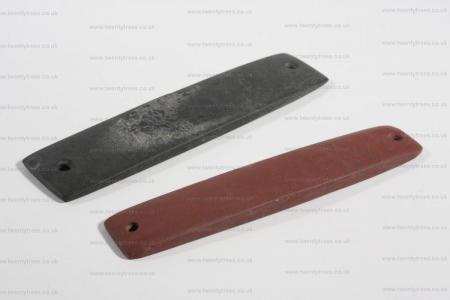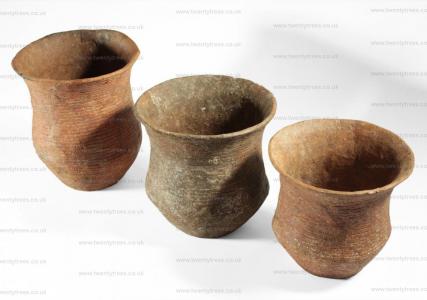Flint Arrowhead
Flint Arrowhead is in Flint Artefacts.
2300BC. Stonehenge Archer [Map] is remains of a man aged around thirty at his death who died around 2300BC found in the Outer Ditch of Stonehenge. With his remains were a stone wrist guard and a number of flint arrowheads. Several of the arrowheads' tips were located in the skeleton's bones, suggesting that the man had been killed by them.
In 1978 his remains were excavated by Richard J C Atkinson and Professor John G Evans. The remains are now in display in Salisbury and South Wiltshire Museum [Map].
2300BC. Boscombe Bowmen [Map] is the remains of a shared burial of around 2300BC found at Boscombe Down Amesbury. The grave contained seven burials: three children, a teenager and three men. The teenager and men appear to have been related. The eldest man was buried in a crouched position with the bones of the others scattered around him, and their skulls resting at his feet. Several flint arrowheads, a boar tusk, flint tools and eight Beaker Ware vessels were found found with the remains. Lead isotope analysis indicates the men grew up in South Wales or the Lake District. The remains are on display at Salisbury and South Wiltshire Museum [Map].
Thomas Bateman 1824. About 350 yards westward from Arbor Lowe [Map] is a barrow of very large size, called Gib Hill [Map], which is connected with the temple of Arbor Lowe by a considerable rampart of earth, now, however, faint and broken, which runs in a serpentine direction towards this barrow, having its commencement at the foot of the vallum of the temple, near the southern entrance. This tumulus is very conical, and rises to the height of about eighteen feet, and has the usual basin-like concavity on its summit. Its height, immense size, and remote antiquity are calculated to impress the reflecting mind with feelings of wonder and admiration. On opening this barrow it was found to consist of earth and limestone, divided by layers of amygdaloid, and in the centre a bed of very stiff reddish-brown clay, completely saturated with what was supposed to be animal matter, most probably arising from the decomposition of human bones. This bed or stratum of clay was laid upon the natural surface, to the depth of about a yard and a half; it was about three yards in diameter, and about five yards from the summit of the mount; this clay was intermixed with a considerable quantity of charcoal and burnt human bones, and a small sprinkling of rats' bones. From it were taken an arrow-head of flint, two and a half inches long, and unburnt, and a fragment of a basaltic celt.
Section I Tumuli 1843. The first tumulus opened this season was situate upon the Meadow-place Farm, near Yolgrave, and is generally known as Bee Lowe [Map]; it was decided upon to open it on the 16th of June, when it was found to be impossible to excavate it in a proper manner, owing to the trees growing upon the sides; therefore the only method of examining it was by sinking a hole down the centre of the mound, which consisted of loose earth and stones, amongst which a profusion of rats' bones was met with. In the course of this excavation the broken fragments of a human skeleton were turned up, which made it evident that one interment at least had been disturbed at some former period. Amongst these bones were found a small arrow-head of flint, elegantly formed, two rude instruments of the same material, and about half a dozen horse's teeth. On reaching the native soil, which was about four feet from the top of the barrow, the primary deposit was found, consisting of burnt bones, amongst which was part of a bone pin, also calcined; and near to the same place lay some fragments of a well-baked clay urn, very tastefully ornamented with a chevron pattern, and which had been of the form of vessel designated "drinking cups" by Sir Richard Hoare, by which name they will be distinguished in the subsequent parts of this work, as a simple way of expressing their difference from the sepulchral urns and incense cups, although it is by no means certain that they were made use of for the purpose implied by the words "drinking cup."
Section I Tumuli 1843. August the 5th 1843 was opened a barrow called Elk Lowe [Map] (quere Ell? that being the ancient British word signifying conspicuous) situate on a considerable eminence near Newhaven. It is of the form which Dr. Stukeley assigns to Druids' barrows without any substantial grounds. The only point in which this kind of tumulus differs from the general form being in the central depression which in this case is so much extended as to spread out into a level and circular area surrounded by a more elevated ring or rampire of earth or stones. In the barrow in question this circle was constructed of very large stones inclining towards the central plain, and covered with small stones and earth, thus forming an extremely durable erection to the height of about three feet, whilst the interior area is not more than one foot above the level of the surrounding soil. In the centre of this space, upon a stratum of stiff clay, was laid a skeleton, whose head rested upon a large limestone. This clay, appearing to replace soil (which had been removed for about a foot in depth below the natural surface), was dug out and carefully examined, and from amongst it were taken a large flint arrow- or lance-head, three other instruments of the same material, and a small piece of sandstone, rubbed smooth. These articles were immediately beneath the skeleton, on whose right hand lay a deposit of burnt human bones, containing an arrow-head of flint, also calcined, and a considerable quantity of charcoal, amongst which were several hazel-nuts, still retaining their perfect form. In other parts of the area, the remains of two more skeletons and some fragments of a large urn, composed of imperfectly baked clay, profusely ornamented, were found. A few dogs' teeth were also observed. The most remarkable circumstance attending the opening of this barrow was the discovery of rats' bones in an unprecedented quantity the whole of the interior circle of the area being covered with a stratum of them not less than three inches in thickness.
Section I Tumuli 1843. 4th of September, 1843, a small barrow, about two miles south of Middleton-by-Yolgrave [Map], named Borther Lowe [Map], was investigated, first by digging down the centre, and afterwards by cutting it through to the south side. In the first excavation pieces of urns, horses' teeth, and other bones were immediately found. Proceeding lower down, upon the level of the ground on which the barrow was raised, a rude kind of pavement of rough limestones was found, which was covered with a layer of rats' bones. Yet no human bones were discovered in this part of the mound, which was therefore abandoned, and the south side subjected to an examination, with better success. The ground on the south being removed to the depth of a foot, a skeleton, with the head lying towards the interior of the barrow, was uncovered. It was found to be in a very decayed state, from its being placed so near the surface, within the influence of the atmosphere. On the left side of the skeleton were the remains of a plain, coarse urn, much disintegrated, owing to the reason above stated, a flint arrow-head, much burnt, a pair of the canine teeth of either a fox or a dog of the same size, and a diminutive bronze celt. The contemporary use of weapons of flint and bronze is remarkable: in another place are a few observations bearing upon this point. In other parts of the tumulus were three hones of fine slatestone. In an adjoining field are the remains of another barrow, removed in order to supply materials for a stone fence at the least expense; but there are no records of any discovery of interments having been made at the time.
Books, Prehistory, Prehistoric Artefacts, Flint Artefacts, Barbed Flint Arrowhead
The Amesbury Archer [Map] is the remains of a man aged around forty at the time of his death from the Alps who was buried in Amesbury around 2300BC and discovered in May 2002 during the development of new housing. He is named 'The Archer' as a consequence of the large number of arrowheads found with him. His grave contained the largest number of artefacts of any grave of a similar period including the earliest known gold objects in England, five beaker funerary pots, three tiny copper knives, sixteen barbed flint arrowheads, a kit of flint-knapping, metalworking tools including cushion stones and some boar tusks. On his forearm was a black stone wrist guard. A similar red wrist guard was by his knees with a shale belt ring and a pair of earrings, the oldest gold objects found in England. An eroded hole in his jaw showed that he had suffered from an abscess, and his missing left kneecap suggests that he had an injury that left him with a painful lingering bone infection. His remains are on display in the Salisbury and South Wiltshire Museum [Map].
The Amesbury Archer's Companion is the remains of a man raised locally aged between twenty-five and thirty at the time of his death buried around 2300BC near to the Amesbury Archer. He appears to be related to the Amesbury Archer as they shared a rare hereditary anomaly, calcaneonavicular coalition, fusing of the calcaneus and of the navicular tarsal (foot bones). Inside his jaw were found a pair of gold earrings or hair ornaments in the same style as the Amesbury Archer's.
Photos sourced from Salisbury and South Wiltshire Museum [Map] and Wessex Archaeology.
